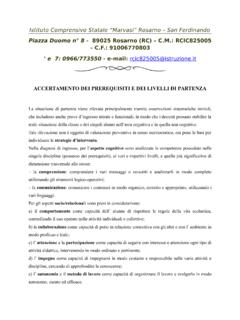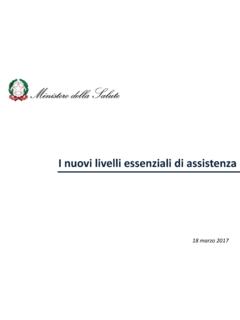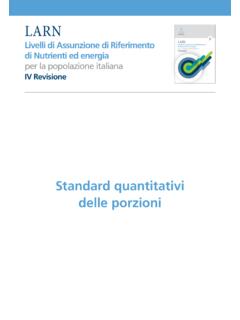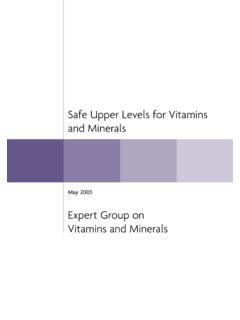Transcription of Marginalised Australians: Characteristics and Predictors ...
1 Marginalised Australians: Characteristics and Predictors of Exit Over Ten Years 2001-10 Suggested citation: Cruwys, T., Berry, , Cassells, R., Duncan, A., O Brien, , Sage, B. and D Souza, G. (2013). Marginalised Australians: Characteristics and Predictors of Exit over Ten years 2001-2010. University of Canberra, Australia. Marginalised Australians Tegan Cruwys 1,2 Helen Berry 1 Rebecca Cassells 3 Alan Duncan 1,4 L an O Brien 1 Brie Sage 1 Gabriela D Souza 1 1. Faculty of Health, University of Canberra 2. School of Psychology, University of Queensland 3. National Centre for Social and Economic Modelling, University of Canberra 4. Bankwest Curtin Economics Centre, Curtin University Acknowledgements This project was funded by the ACT government Community Services Department and the Faculty of Health at the University of Canberra.
2 All comments and inquiries regarding this project should be addressed to Professor Helen Berry. This research report builds on earlier work by Berry et al. (2008), which identified five archetypes of people in Australia - one of which were Marginalised Australians. This report uses unit record data from the Household, Income and Labour Dynamics in Australia (HILDA) Survey. The HILDA project was initiated and is funded by the australian Government Department of Families, Housing, Community Services and Indigenous Affairs (FaHCSIA) and is managed by the Melbourne Institute of Applied Economic and Social Research (Melbourne Institute). The findings and views reported in this paper, however, are those of the authors and should not be attributed to either FaHCSIA or the Melbourne Institute.
3 Marginalised Australians Page 2 of 43 Contents Executive Summary .. 4 Chapter One: Introducing Marginalisation and the Aims of this Study .. 6 Contemporary australian Archetypes: Different People, Different Needs .. 6 Project Aim .. 6 Introducing Marginalisation: Five Domains of Disadvantage .. 8 Social stigmatisation .. 9 Early-life disadvantage and its intergenerational transfer .. 9 Financial hardship .. 9 Poor 10 Social Isolation .. 10 Chapter Two: Predicting Exit from Marginalisation .. 11 A Representative Sample of Australians .. 11 Identifying Marginalised Individuals .. 11 Exit from Marginalisation: Isolating Fixed and Modifiable Predictors of Exit .. 11 Fixed Demographic Predictors .
4 15 Modifiable Early-Life Predictors .. 16 Modifiable Financial Predictors .. 19 Modifiable Health Predictors .. 21 Modifiable Social and Relational Predictors .. 23 Predictors of Exit from Marginalisation .. 24 Chapter Three: Conclusions & Policy Implications .. 25 Key findings from the current study .. 25 Trajectories Out of Marginalisation .. 25 Features of Persistent Marginalisation .. 26 Services for Persistent Marginalisation .. 26 Implications for Integrated Service Provision .. 27 Supporting Women at Risk .. 27 Welfare Support and Workforce Participation .. 29 Links to Current ACT Government Policy .. 31 Towards a Simple Tool to Measure Marginalisation .. 31 References.
5 33 Appendix 1 .. 36 Appendix 2 .. 37 Appendix 3 .. 39 Marginalised Australians List of figures Figure 1 Decline in the Probability of Remaining Marginalised As Age Increases .. 15 Figure 2 Ethnicity of Persisters and Exiters compared to those Never Marginalised .. 15 Figure 3. Moving Out of the Childhood Home at a Young Age Increases the Risk of Persistent Marginalisation.. 16 Figure 4. Obtaining a Tertiary Education is a Strong Predictor of Exit from Marginalisation.. 18 Figure 5. Obtaining a Certificate or Diploma Reduced the Likelihood of Exiting Marginalisation.. 18 Figure 6. Type of Income Support Received Predicts Likelihood of Remaining in Marginalisation.. 20 Figure 7.
6 Commencing Full-Time Employment Predicts Exit from 20 Figure 8. Commencing Part-Time Employment Does Not Predict Exit from Marginalisation.. 20 Figure 9. Failure to Recover from a Long-Term Health Condition Predicts Remaining Marginalised .. 22 Figure 10. Continuing Poor and Worsening Mental Health Predicts Remaining Marginalised .. 22 Figure 11. Risk of Remaining Marginalised is Influenced by Having Further Children for Women, but not Men.. 23 List of tables Table 1. Contemporary australian Archetypes.. 7 Table 2. Marginalisation Five Domains of 10 Table 3. Marginalisation in Australia.. 11 Table 4. Characteristics of Persistently Marginalised Persons and Exiters of Marginalisation.
7 14 Table 5. Non Modifiable and Potentially Modifiable Factors Found to Predict the Risk of Remaining Marginalised after a 10-year Period.. 24 Marginalised Australians Page 4 of 43 Executive Summary A decade ago, 13 per cent of australian adults were living in extreme, multifaceted disadvantage, or Marginalised circumstances, defined as a complex mix of economic, social, early-life and health disadvantage. Following up 866 of these Australians ten years on, over a period of primarily strong economic growth, we find that almost 60 per cent had managed to exit marginalisation. Others remained Marginalised and still others were new entrants to marginalisation. The focus of this research report is to compare those who remained Marginalised between 2001 and 2010 with those who managed to exit marginalisation.
8 This comparison provides powerful information for policy decision-making and service design through identifying protective factors that predict exit from the profoundly disadvantaged state of marginalisation. It also indicates potential pathways towards leading a happy and productive life when facing such a situation, as well as some of the barriers to doing so. The concept of marginalisation applied in this study stems from an innovative approach to conceptualising multi-faceted disadvantage. This novel approach allows a more complete picture of what distinguishes the lives of multiply disadvantaged people from the lives of other people in the community. Persisters and exiters Important differences between individuals who were persistently Marginalised versus those who exited marginalisation are revealed.
9 Persisters are much more likely than exiters to have experienced early-life disadvantage particularly moving out of home at a very young age, leaving school early and experiencing parental unemployment or divorce. Persisters were three times more likely to leave school before the age of 16, compared with the overall population, whereas exiters were twice as likely to have left home before the age of 18. Persisters were more likely to be members of stigmatised groups Indigenous Australians, unemployed people and welfare-reliant single mothers and were also more likely to experience chronic health problems, particularly disability and mental illness, and to suffer from financial deprivation: more than one-half of this group were living below the poverty line.
10 By contrast, those individuals who were temporarily Marginalised (noting that temporarily could be a long time) but who managed to exit ten years later experienced a dramatic improvement in their financial circumstances. Transitioning from government income support to full-time work, these individuals experienced a substantial increase in their disposable income and many were able to move from renting to buying their home. Women more Marginalised than men A key finding in this report is the much higher proportion of women than men living in Marginalised circumstances two-thirds of those Marginalised in 2001. Women were also more likely to remain Marginalised , with the proportion of women increasing from 67 to 75 per cent over the decade.







